Your Calls?
Which of today’s four featured Roseate Spoonbill images is your favorite? Why? Which of the three Stick Marsh cards do you think has the strongest collection of images?
In the Last Post and More on Processing Backlit Images
Thanks to those who commented at the last post. All four images garnered a mention. The leader by a small margin was the backlit Iguana. Speaking of backlight, I have finished Volume III of the Digital Basics III Video Series. It will will be sent to series purchasers and be available in the BAA Online Store no later than Monday. It covers the use of the new Super Resolution feature in ACR 17.5 and introduces and details the use of the masking feature during and after raw conversions in ACR 17.5 (in both Photoshop and Lightroom).
My favorite by a small margin is the Anhinga tossing a fish. Why? It is my first image of this behavior and is pretty much wonderful. Not to mention the perfect fish position and pose.
Don’t Just Shoot: Learn
If you are interested in changing your life and becoming a better photographer by joining me on the Extended IPT at Sebastian Inlet for Ospreys and more (NOV 22-through the morning of the 24th), in San Diego for Pacific-race Brown Pelicans and more (JAN 6 to FEB 2, 2026) as below, or for Roseate Spoonbills at Stick Marsh (March 2026 — details below!), please e-mail for dates, rates, terms, and additional information. Or shoot me a text to 863-221-2372. Most offerings include options for shared AirBnB lodging and meals. Ground transportation during your stay is a possibility at times.
What’s Up?
Recently, necessity has very much been the mother of invention at Sebastian Inlet. With the relentless northwest winds of varying strength every morning, we have been doing lots of backlit flight photography with the “wrong wind” and creating some stunning silhouettes as well. We arrive very early for the best color and as a result, have also been making lots of intentionally blurred images. We’ve been working birds in the shade of the inlet bridge, doing back shots of bathing terns, creating occasional “look back, over-the-shoulder” images, and working sunlit birds in Northwest Cove that happen to to momentarily wind up square to the back of the camera. It has been a great learning experience for me, and in addition, I have significantly improved my processing skills while dealing with photos created in less than ideal wind-against-sun conditions (especially the backlit ones on cloudy mornings).
Today is Saturday 15 November and — no shock here, the forecast is calling for clear skies and a breeze from the NW. As always in these conditions, we are hoping for some clouds on the eastern horizon; there are almost always some. With the northwest winds, the higher the cloud bank over the Atlantic, the better. We will be head out early. Whatever you opt to do, I hope that you too choose to have a wonderful and productive day.
If an item — a Delkin flash card or reader, a Levered-clamp FlexShooter Pro, or a Wimberley lens plate or low foot — for example, that is available from B&H and/or Bedfords, is also available in the BAA Online Store, it would be great, and greatly appreciated, if you would opt to purchase from us. We will match or beat any price. Please remember also to use my B&H affiliate links or to earn 3% cash back at Bedford by using the BIRDSASART discount code at checkout for your major gear purchases. Doing either often earns you free guides and/or discounts. And always earns my great appreciation.
Gear Questions and Advice
Too many folks attending BAA IPTs and dozens of photographers whom I see in the field and on BirdPhotographer’s.Net, are — out of ignorance — using the wrong gear, especially when it comes to tripods and more especially, tripod heads. And the same is true in spades when ordering new camera bodies or lenses. My advice will often save you some serious money and may help you avoid making a seriously bad choice. Please know that I am always glad to answer your gear questions via e-mail. If you are desperate, you can try me on my cell at 863-221-2372. Please leave a message and shoot me a text if I do not pick up.
B&H Simplified
To ensure that I get credit for your B&H purchases, you can always click here. The tracking is invisible but using my affiliate links is greatly appreciated. And, with B&H, you can use your PayBoo card. You must use the website to order. You cannot get your free guides if you make a phone order. Once you have an item in your cart, you must complete the order within two hours. Huge thanks!
B&H
Many folks have written recently stating that they purchased a Sony a1 from B&H and would like their free membership in the Sony 1 Info and Updates Group, a $150.00 value. But when I check my affiliate account, their orders have not been there. When I let them know that they get credit for B&H purchases only if they use one of the many B&H affiliate links on the blog or begin their searches with this link, they are always disappointed. If in doubt, please contact me via e-mail and request a BH link. I am always glad to help and to guide you to the right gear.
Bedfords Simplified
Click here to start your search. Choose standard shipping, and when you get to the payment page, enter BIRDSASART in the discount code box and hit apply. You will be upgraded to free second day air Fed-Ex and receive 3% cash back on your credit card once your stuff ships. Using either my affiliate links is greatly appreciated and will often earn you free guides or discounts. To receive a free guide or free entry into a Sony Set-up and Info Notes e-Mail group, you need to shoot me your receipt via e-mail. The B&H receipts need to include the order number.
Bedfords Amazing BAA Discount Policy
Folks who have fallen in love with Bedfords can always use the BIRDSASART coupon code at checkout to enjoy a post-purchase, 3% off-statement credit (excluding taxes and shipping charges) on orders paid with a credit card. The 3% credit will be refunded to the card you used for your purchase when your product ships. Be sure, also, to check the box for free shipping to enjoy free Second Day Air Fed-Ex. This offer does not apply to purchases of Classes, Gift Cards, or prior purchases.
You can visit the Bedfords website here, shoot Steve Elkins an e-mail, or text him on his cell phone at (479) 381-2592.
|
|
|
This image was 7 March 2025 by yours truly on a Stick Marsh IPT. Seated on a milk crate, I used the hand held Sony FE 300mm f/2.8 GM OSS Lens (Sony E) and The Latest Greatest Sony Flagship Body, the a1 II Mirrorless Camera. ISO 800. Exposure determined via Zebras with ISO on the Thumb Wheel; 1/4000 sec. at f/2.8 (wide open) in Manual mode. RawDigger showed that the exposure was dead solid perfect: AWB at 7:08:48am in soft, early morning sunlight. Tracking Zone/AF-C with Bird Eye/Face Detection enabled performed perfectly. Image #1: Roseate Spoonbill braking to land |
Focal Lengths for Incoming Spoonbills
You do not need a long lens to photograph the incoming spoonbills braking to land at stick Marsh. For years, I used a 70-200mm f/2.8 GM II lens almost always with the 1.4X teleconverter. One I got the 300mm f/2.8 GM lens, it quickly became my favorite for the one full stop of extra speed that it provided. I love being able to use one full stop less ISO as compared to the 70-200mm at 280mm f/4. The zoom set-up allows you to zoom out when needed while you will often be clipping wings at 300mm.
|
|
|
This image was created on 9 March 2025 by yours truly on a Stick Marsh IPT. Seated on a milk crate, I used the Robus RC-5570 Vantage Series 3 Carbon Fiber Tripod/Levered-Clamp FlexShooter Pro-mounted Sony FE 600mm f/4 GM OSS lens with the Sony FE 1.4x Teleconverter and the Latest Greatest Sony Flagship Body, the a1 II Mirrorless Camera. Exposure determined via Zebras with ISO on the Thumb Wheel. ISO 1600: 1/2500 sec. at f/7.1 (stopped down 2/3 stop in error) in Manual mode. RawDigger showed that the exposure was perfect. AWB at 8:42:03am on a then cloudy morning. Wide/AF-C with Bird Eye/Face Detection enabled performed perfectly. Click on the image to enjoy the larger, inexplicably sharper high-res version. Image #2: Roseate Spoonbill flat, incoming flight |
Messing Around at 840mm
For several years I would play around with the 600 and a 1.4X TC on the tripod to try for point blank head shots of the incoming spoonies. I got a few good ones. With Image #2, I captured a nice flat flight pose of a relatively distant incoming bird. Part is the key to the success of this image was being able to center the spoonbill in the swath of distant vegetation.
|
|
|
This image was created on 27 March 2025 at Stick Marsh, Fellsmere, FL. Seated on a sturdy plastic milk crate topped with an old pillow, I used the hand held Sony FE 400-800mm f/6.3-8 G OSS lens (Sony E) (at 418mm) and The Latest Greatest Sony Flagship Body, the a1 II Mirrorless Camera. The exposure was determined by Zebras with ISO on the rear wheel — ISO 2500: 1/2500 second at f/8 (wide open) in Manual mode. RawDigger showed that the exposure was perfect. AWB at 7:52:12am on sunny morning. Tracking: Zone/AF-C with Bird-Eye/Face Detection performed perfectly. Click on the image to enjoy the larger, inexplicably sharper high-res version. Image #3: Roseate Spoonbill braking to land in early morning light |
Playing with a New Toy
When I first borrowed a 400-800 from Sony and brought it to Stick Marsh, I did not think that it would prove to be very useful. Boy, was I wrong. Even when the sun was not out, I handheld the lens and made a stack of new and different images. Seven of the nine images on Stick Marsh Card Two below were created with my new toy. All but the sunset silhouette and the Anhinga with the speared bass were created with the 4-8 at focal lengths ranging from 418 to 800mm! I love both the reach and the versatility of this amazing zoom lens.
|
|
|
This image was 29 March 2025 by yours truly on a Stick Marsh IPT. Seated on a milk crate, I used the hand held Sony FE 300mm f/2.8 GM OSS Lens (Sony E) and The Latest Greatest Sony Flagship Body, the a1 II Mirrorless Camera. ISO 1600. Exposure determined via Zebras with ISO on the Thumb Wheel; 1/1600 sec. at f/2.8 (wide open) in Manual mode. RawDigger showed that the exposure was dead solid perfect: AWB at 7:31:21am on a partly cloudy morning. Tracking Zone/AF-C with Bird Eye/Face Detection enabled performed perfectly. Image #4: Roseate Spoonbill taking flight |
A-1 ii Pre-capture
Sony a-1 ii users and users of other makes that offer a pre-capture feature have a huge advantage with take-off images. Provided that they understand the technology and have their camera bodies set up properly.
Discovering Stick Marsh
I had been hearing about Stick Marsh for well more than a decade. Everyone who mentioned stated that you needed a boat. After trying to photograph Florida’s most-wanted avian subject for several decades with long lenses, I finally visited in March 2020. Once I got the lay of the land, I realized that photographing from the shoreline would be much better than being in a boat. Roseate Spoonbill is the holy grail subject for bird photographers visiting Florida (and for those who live here as well). When I think that I had been living just one hour ten minutes from this spot for more than two decades, I really want to kick myself. But I won’t. I spent a good deal of time at Stick Marsh in 2020, 21, 22, 23, and 24 and learned a ton. I cannot wait to get back there this season.
|
|
Stick Marsh Card One. Click on the composite to enjoy a larger version.Clockwise from upper left back around to the center: 1-year old spoonbill braking to land (400mm); spoonbill with nesting material; spoonbill braking to land blur (300mm) (300mm); spoonbill grabbing stick 840mm); 1-year spoonbill while sky flight (300mm); spoonbill with green background (300mm with 2X TC = 600mm); sub-adult spoonbill on rock in pink pre-dawn light; adult spoonbill looking back pose (840mm); and spoonbill tight flight (840mm) |
Stick Marsh IPT: #1: WED 4 March thru the morning session on MON 9 March 2026: 5 1/2 DAYS: $2,999.00 (*). (Limit 4 photographers/Openings 3.)
Stick Marsh IPT: #2: TUES 24 March thru the morning session on SUN 29 March 2026: 5 1/2 DAYS: $2,999.00 (*). (Limit 4 photographers)
(*) Folks opting not to stay at the IPT AiBnB (details below) please add $999.00. That brings the cost of the IPT to $3998.00.
If you would like to explore the possibility of doing both Spoonbill IPTs and spending a week with me at Indian Lake Estates photographing Sandhill Crane courtship and hopefully some pairs with small chicks in between, please get in touch via return e-mail and I will be glad to share the details with you.
Stick Marsh, where the Photography is Easy
Stick Marsh, where the living is easy. Photograph incoming Roseate Spoonbills in flight at point blank range with intermediate telephoto zoom lenses. This year I will be using the Sony 70-200mm f/2.8 II GM Lens, often with the 1.4X TC, the 300mm f/2.8 GM Lens, and the 400-800 G Lens. Longer lenses either on a tripod or hand held are ideal for the green background stuff. There will be endless flight photography opportunities with a variety of species. In addition to the spoonbills, we should have some excellent chances on Limpkin, Great Egret, Cattle Egret, Great Blue Heron, Little Blue Heron, Double-created Cormorant, Anhinga, Black and Turkey Vultures, and more. Folks with 500 and 600mm f/4 lenses will have lots of opportunities to hone their skills working on a tripod or hand holding.
There will be six morning photo sessions averaging three hours each. We start in the pre-dawn. The first five morning sessions will be followed by brunch (the cost is included). There will be four after brunch/after Instructor Nap Time image review/Photoshop sessions. There will be two evening photo sessions. We will be based in Vero Lake Estates. The deposit is $899.00. Call Jim at the office any weekday at 863-692-0906 to pay by credit card. Balances must be paid by check.
|
|
Stick Marsh Card Two. Click on the composite to enjoy a larger version.Clockwise from upper left back around to the center: Great Egret landing sunset silhouette; spoonbill in flowers: spoonbill preening upper tail coverts; Anhinga calling; spoonbill stepping in soft light; Great Egret with nesting material; Wood Stork with nesting material; Anhinga with speared largemouth bass; and spoonbill flight head portrait. |
What You Will Learn on a Stick Marsh IPT
- 1- You will learn the basics and fine points of digital exposure. Nikon and Canon folks will learn to get the right exposure every time after making a single test exposure, and SONY folks will learn to use Zebras so that they can be sure of making excellent exposures before pressing the shutter button..
- 2- You will learn to work in Manual exposure mode even if you are scared of it.
- 3- You will surely learn to evaluate wind and sky conditions and understand how they affect bird photography.
- 4- You will learn the pro secrets that will help you to become a better flight photographer.
- 5- You will learn to zoom out in advance (because the birds are so close!) 🙂
- 6- You will learn how to approach free and wild birds without disturbing them.
- 7- You will learn to spot the good and the great situations.
- 8- You will learn to understand and predict bird behavior.
- 9- You will learn to design pleasing images by mastering your camera’s AF system.
- 10- You will learn to choose the best perspective.
- 11- You will learn to see and control your backgrounds.
- 12- You will learn to see and understand the light.
- 12- You will learn to see and create pleasing blurs in pre-dawn situations.
- 12- You will learn to be ready for the most likely event at all times.
And the best news is that you will be able to take everything you learn home with you so that you will be a better photographer wherever you are and whenever you photograph.
|
|
Stick Marsh Card Three. Click on the composite to enjoy a larger version.Clockwise from upper left back around to the center: spoonbill with mangrove background; spoonbill head and shoulders portrait; spoonbill braking to land; spoonbill dramatic landing pose; adult Black-crowned Night-Heron; spoonbill with nesting material; Great Egret returning to nest; incoming spoonbill; and Limpkin landing. |
AirBnB Details
We will be staying at the same great AirBnb that I used for Stick Marsh in 2024 and Sebastian Inlet for a month in 2024 and two months in 2025.
For the full IPT the cost of your private room in a lovely home will be $150/night. Arrive on the afternoon before the first day of the IPT and check out by 11am on the day of our last shooting session.
As above, brunch is on me. Dinners are provided for $25/day. I am an excellent chef and the food is both healthy and of high quality.
Getting There
You can fly to Orlando International Airport (MCO) and rent a car or fly to Melbourne International Airport (MEL) and explore the possibility of airport pick-up and drop-off or a taxi or uber ride to and from the AirBnB for those who opt to ride with me. Rides with me are available for $25/day/person on an extremely limited space available basis. To avoid the cost of a rental car, be sure to book early.
Deposit Information
A non-refundable deposit by check is required to hold your spot. The amount will be $899.00 plus half the cost of the AirBnB lodging. Please contact me by e-mail to check on availability and then make the check out to:
BIRDS AS ART
And send it via US Mail to
BIRDS AS ART
PO Box 7245
Indian Lake Estates, FL 33855
Thank you kindly.
Travel Insurance
Travel insurance for both big international trips and US-based IPTs is highly recommended as we never know what life has in store for us. I strongly recommend that you purchase quality travel insurance. Travel Insurance Services offers a variety of plans and options. Included with the Elite Option or available as an upgrade to the Basic & Plus Options you can also purchase Cancel for Any Reason Coverage that expands the list of reasons for your canceling to include things such as sudden work or family obligation and even a simple change of mind. My family and I use and depend on the great policies offered by TIS whenever we travel. You can learn more here: Travel Insurance Services. Do note that many plans require that you purchase your travel insurance within 14 days of our cashing your deposit check or running your credit card. Whenever purchasing travel insurance, be sure to read the fine print carefully even when dealing with reputable firms like TSI.
Via e-mail from Morris Herstein
I never thought that I could make in-flight photos of birds successfully. That goal was accomplished during the recent workshop at Stick Marsh only because I listened to your advice and instructions. For the first time I realized how important sun angle was, teachings that you had been communicated for a long time. The result of two days shooting produced the most satisfying images of Roseate Spoonbills I ever could have imagined.
Stay well and safe. Thank you. Morris
Via e-mail from Joe Usewicz
Wow. So many photos to go through. Stick Marsh was a great learning experience. Positioning. Wind impact. Landing zones. Working on backgrounds. I clipped too many incredible reflections. Great fun. Just amazing opportunities.
Warmest Regards, Joe
The BIRDS AS ART SONY 400-800mm f/6.3-9 G Super-telephoto Zoom Lens Guide
For the past three NW wind mornings at Sebastian Inlet I have used my 400-800 exclusively. With a the lens atop a Levered-Clamp FlexShooter Pro on the Robus RC-5570 Vantage Series 3 Carbon Fiber Tripod; it has been both productive and fun.
When I borrowed this lens from Sony, I assumed that at 5.45 pounds it was too heavy to handhold for long and that at f/8 at the long end (800mm,) it was too slow for most bird photography applications. In short, I did not want to like the lens. After a month of using it, I cannot live without it. After returning the loaner, I was miraculously able to get my own from Bedfords on 16 April 2025. In this guide I share everything that I have learned about using the 400-800. For best results, you need to know exactly what you are doing to get the most out of this zoom lens. It would be best, therefore, to consider and study the material in the guide so that you can begin making great images with your new lens.
You will learn how to deal with the relatively show apertures: f/6.3, f/7.1, and f/8 when working in Manual mode.
You will learn how to ensure that you are working at the widest aperture by working in Shutter Priority mode with AUTO ISO.
If you are able to hand hold the lens, you will learn proper hand holding techniques.
If you can’t, you will learn when, why, and how to employ other options. Those include:
1- The knee-pod, heel-pod, and toe-pod techniques
2- Using the lens on a monopod.
3- The best lens plate and low foot for your 4-8.
4- The best tripod and head for the 4-8 and how best to utilize them.
5- How to use the lens from your vehicle while supporting it on a BLUBB (or not and why not).
6- Detailed instructions on how to set and use the lens controls and buttons:
a- AF/MF
b- DMF Switch
c- Limit Range Switch
d- OSS (Optical Steady Shot) Switch
e- OSS Mode Switch
f- Focus Hold Buttons
The guide also includes a Hand Holding Shutter Speed Primer and an illustrative, educational, and inspiring 67-image gallery.
Free to folks who use one of my two affiliate links to purchase their Sony 400-800 G lens. Otherwise, please send a PayPal for $115.43 to birdsasart@verizon.net and include the words “400-800 Lens Guide” in your e-mail.
Typos
In all blog posts, feel free to e-mail or to leave a comment regarding any typos or errors.



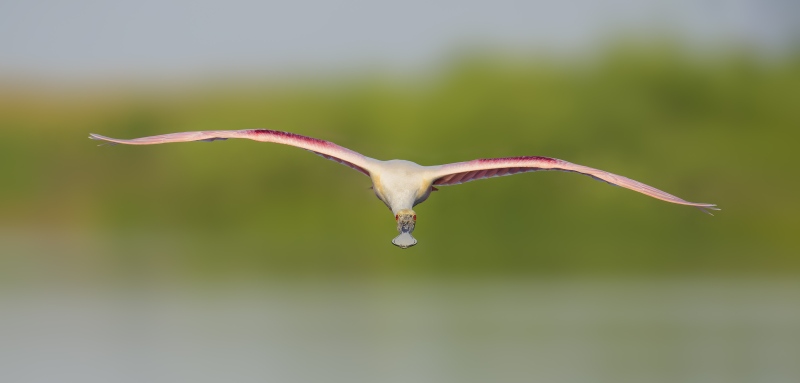
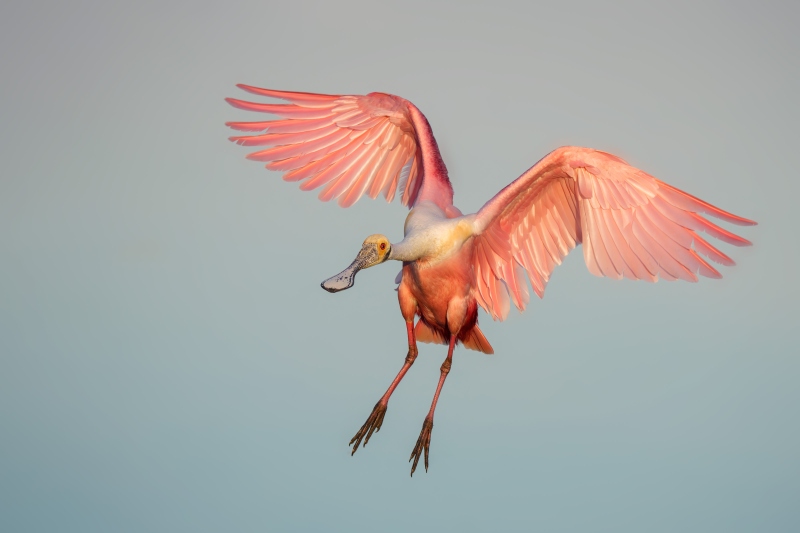

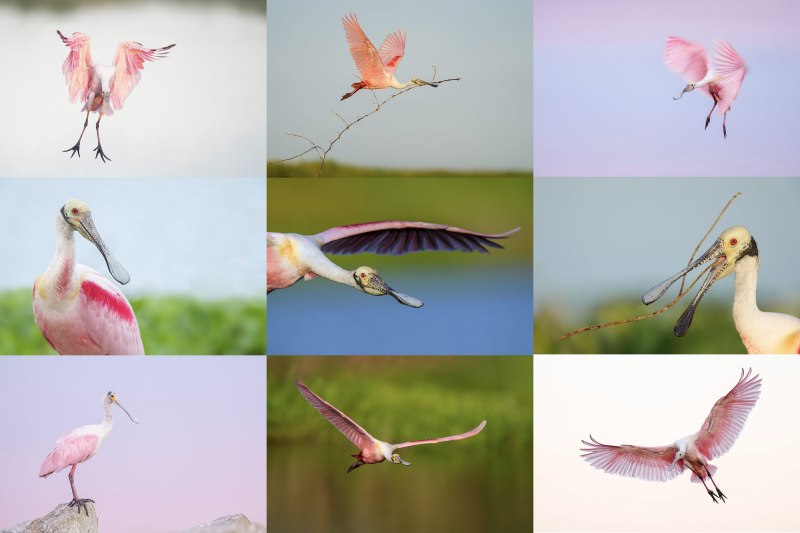

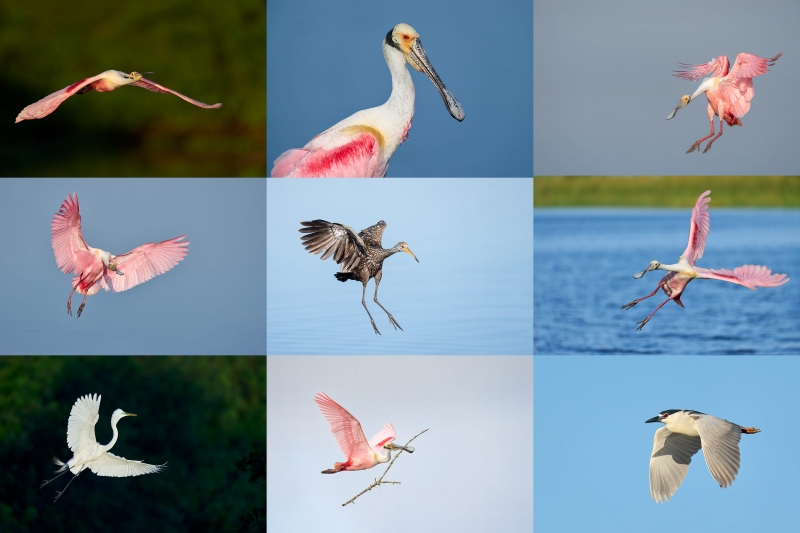
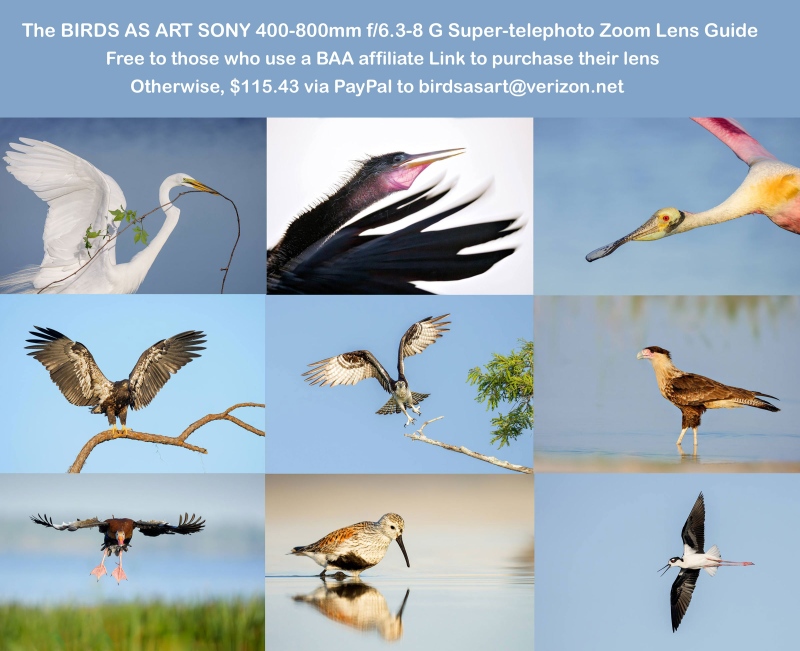






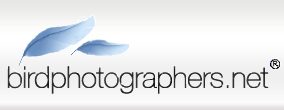


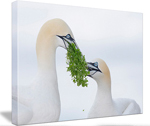
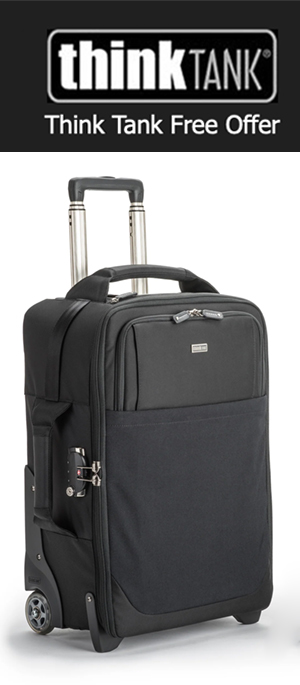


Leave a Reply